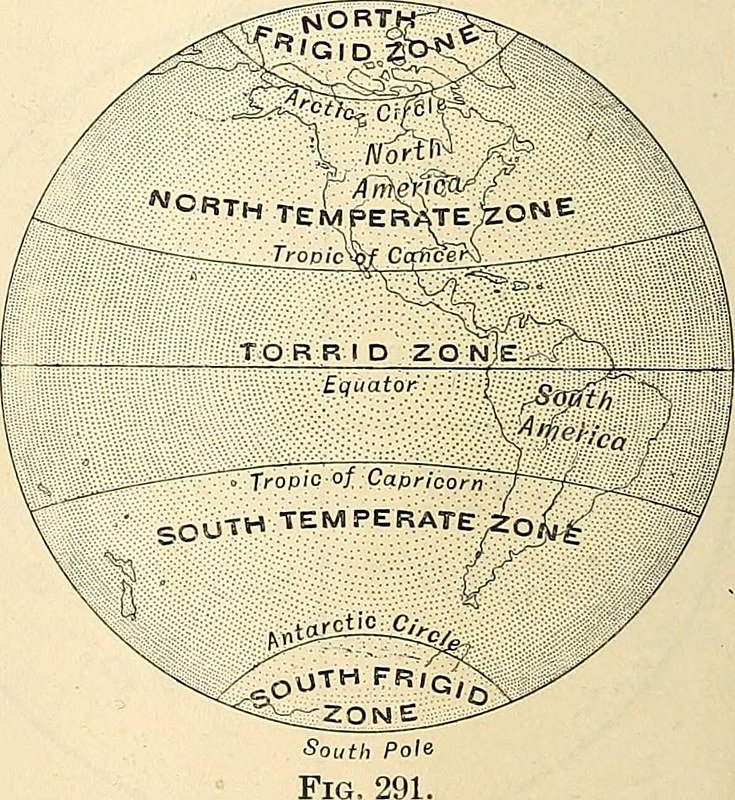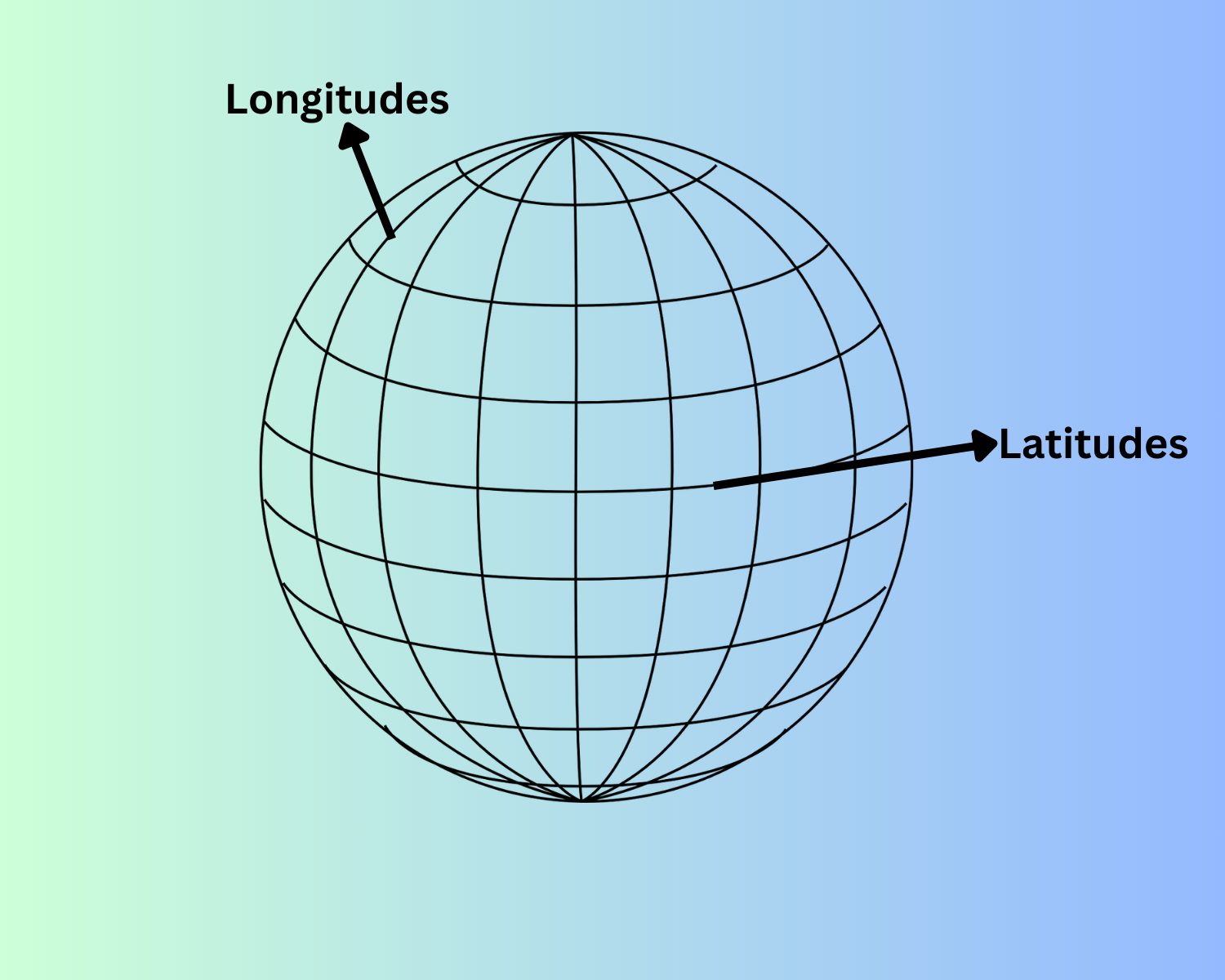Important Parallels of Latitudes:
❖ The Northern Hemisphere’s 23 1⁄2° N latitude is the Tropic of Cancer.
❖ Southern Hemisphere: 23 1⁄2° S latitude is the Tropic of Capricorn.
❖ Arctic Circle, located north of the equator at 66 1⁄2°.
❖ Antarctic Circle, located south of the equator at 66 1⁄2°.
❖ Equator: The globe is divided into two equal parts by an imaginary line known as the Equator.
❖ The Northern Hemisphere is located in the northern half of the Earth, while the Southern Hemisphere is located in the southern half.
❖ Latitude parallels are drawn one degree apart. The length of 1 latitude, or 111 km, would remain constant throughout the earth if it were a perfect sphere. But more precisely, from the equator to the Poles, the degree of latitude varies slightly in length.
❖ It is 111.6 km at the Equator and 111.7 km at the Poles. that is, a degree of latitude’s linear distance is slightly longer at the pole than it is at the equator.
Heat Zones of the Earth:

❖ At the Equator, sunlight falls perpendicularly (overhead), bringing energy per unit time per unit area, or insolation, to the earth.
❖ It forms an angle of about 45 degrees at the Tropics and is entirely oblique at Polar latitudes.
❖ There is high insolation at the Equator, moderate insolation at the Tropics, and low insolation at the Poles. [Therefore, the weather and vegetation in different regions vary due to varying levels of heat and sunlight.]
❖ Torrid Zone: This zone experiences a concentration of overhead radiation, leading to a small area of high insolation.
➢ On all latitudes between the Tropics of Cancer and Capricorn, the midday sun is exactly overhead at least once a year.
➢ It, therefore, receives the maximum heat.
➢ The regions closest to the tropics have the highest temperatures on Earth.
❖ Temperate Zones: Any latitude north of the Tropics of Cancer and Capricorn will never see the midday sun.
➢ As one approaches the poles, the sun’s rays continue to decrease in angle. They experience mild temperatures as a result.
❖ Frigid Zones: A wide region experiences low levels of insolation. Heat energy is not concentrated in this area.
➢In the Northern Hemisphere, the regions situated between the North Pole and the Arctic Circle, and in the Southern Hemisphere, between the Antarctic Circle and the South Pole, are extremely frigid.
➢The reason for this is that the sun doesn’t rise very high above the horizon here.
➢These regions are home to coniferous trees.
➢ There is taiga and tundra vegetation.
| Countries Passing Through | Countries |
| Equator | ❖ South America: Ecuador, Colombia, Brazil ❖ Africa: Sao Tome and Principe, Gabon, Congo, Democratic Republic of Congo, Uganda, Kenya, Somalia. ❖ Asia: Maldives, Indonesia, Kiribati |
| Prime Meridian | ❖ Europe: UK, France, Spain ❖ Africa: Algeria, Mali. Burkina Faso, Ghana, Togo ❖ Antarctica |
| Tropic of Cancer | ❖ North America: Bahamas (Archipelago), Mexico ❖ Africa: Egypt, Libya, Niger, Algeria, Mali, Western Sahara, Mauritania ❖ Asia: Taiwan, China, Myanmar, Bangladesh, India, Oman, UAE, Saudi Arabia |
| Tropic of Capricon | ❖ South America: .Argentina, Brazil, Chile, Paraguay ❖ Africa: Namibia. Botswana, South Africa. Mozambique. Madagascar ❖ Australia |
Longitude:
❖ It’s the angular distance east or west of the Prime Meridian. It is also measured in degrees.
❖ The longitudes range from 0° to 180° to the east and west of the Prime Meridian, which is also referred to as the meridian.
❖ Prime Meridian: The path that passes through the Royal Astronomical Observatory in Greenwich, near London, was designated as the zero meridian in 1884.
❖ From the Equator to the Poles, the longitude difference gets smaller (it reaches its maximum at the Equator).
❖ On the globe, longitude is shown as a series of semi-circles that run from pole to pole passing through the equator. Such lines are also called Meridians.
❖ They perform one crucial function, which is to determine the local time in respect to Greenwich Mean Time, also known as World Time.
❖ At the equator, longitude and latitude are separated by approximately 69 miles.
❖ 49 miles (79 km) is the approximate distance between them at 45 degrees north or south.
❖ The degree of longitude decreases in length from the equator to the pole, and the distance between longitudes reaches zero at the poles where the lines of meridian converge.
❖ The distance between two longitudes is greatest at the Equator and smallest at the Poles.
